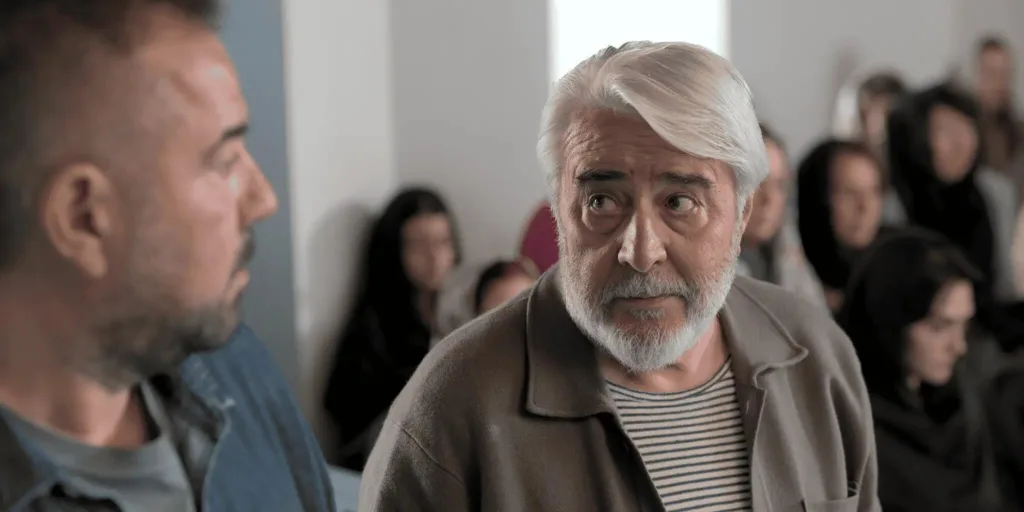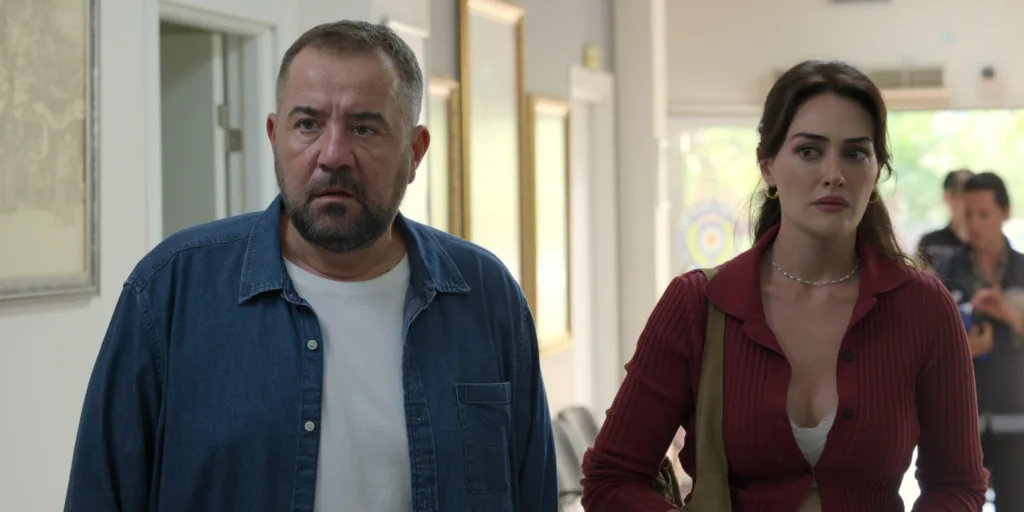“Bet Your Life” (original title “Bir Ihtimal Daha Var”) presents itself as a Turkish production available on a well-known streaming service, merging mystery, comedy, and supernatural aspects into its narrative.
The series centers on Isa, a once-prominent sports betting journalist whose career has suffered a significant downturn. His life takes a startling turn when he encounters the ghost of Refik, a businessman whose death carries hints of foul play rather than a straightforward suicide.
The setting, placed in the scenic Aegean region with much of the action unfolding in the town of Urla, contributes a strong sense of place that reflects the region’s cultural identity. The backdrop of this coastal locale is not merely ornamental; it frames Isa’s personal crisis and the surreal twists of fate he experiences. Everyday hardships intermingle with moments of spectral humor and suspense, creating an atmosphere that invites the viewer to question conventional storytelling methods in television.
Isa’s desperation to regain his former status and settle pressing debts sets the stage for an unusual collaboration with the spirit of Refik. This narrative decision prompts viewers to consider how modern media can mirror societal shifts and offer commentary on issues such as personal accountability, cultural identity, and the unexpected intersections of past and present.
Plot Dynamics and Societal Mirrors
The narrative starts with a dramatic moment when Isa, spurred by desperation and a vivid dream of his late father, makes a daring move that backfires in an unexpected way. This decision introduces a turning point that sets the stage for the unfolding investigation into Refik’s suspicious death.
As Isa finds himself face-to-face with Refik’s ghost, the story shifts from a straightforward tale of sports betting to a layered investigation full of hidden secrets and moral complexities. Isa’s encounter with the spectral figure marks a critical juncture, pushing the storyline into darker territory where personal turmoil and unresolved familial ties come into sharp focus.
His financial struggles and internal conflicts are not merely plot devices; they mirror broader social concerns such as economic instability and the pressure of living up to inherited expectations. The fact that Isa once enjoyed public acclaim in his field, only to be reduced to struggling with debt and reputation, speaks volumes about the precarious nature of fame in a rapidly changing media environment.
The show uses this mystery to examine the undercurrents of family legacy and the influence of personal history on modern identity. In particular, Isa’s connection to his father and the inherited gift of prediction serve as symbols of cultural heritage clashing with contemporary challenges. The series takes a critical look at the world of sports journalism, where the pressure to maintain a public image often overshadows the personal lives of those in the spotlight.
As the investigation into Refik’s death unfolds, the pace of the series builds steadily. Each episode reveals fragments of hidden truths about the circumstances surrounding the businessman’s demise. The buildup of suspense and the intricate layering of subplots invite viewers to reflect on the intersections of personal accountability, cultural expectations, and the evolving nature of storytelling on modern streaming platforms.
Character Portraits and Actor Contributions
Isa stands at the center of the series, a man whose past accomplishments as a sports betting writer contrast sharply with his current struggles. His earlier acclaim in a fast-paced profession now shadows a life marked by financial stress and personal regrets. The character’s internal strife is clearly visible in his impulsive choices, driven by a desire to reclaim lost respect.
His vulnerability creates a nuanced portrayal that speaks to modern pressures on professionals whose reputations can be swiftly tarnished by misfortune. Isa’s interactions with the spectral presence of Refik serve as pivotal moments that gradually transform his skepticism into a reluctant reliance on a guidance he never expected.
Refik appears not simply as a ghost but as a symbolic reminder of past wrongs that refuse to fade quietly into memory. His presence acts as a catalyst for introspection in Isa, adding complexity to a story that might have otherwise remained one-dimensional.
The manner in which Refik’s mysterious demise is interlaced with family history gives his character a weight that affects both the investigation and the evolution of Isa’s identity. His interactions with Isa shift from a jarring shock to a subtle, sometimes humorous exchange that hints at mutual growth.
The ensemble of secondary characters contributes richly to the narrative texture. Seda, for example, injects emotional depth into a storyline already laden with personal conflict. Her role as a counterbalance to Isa’s turbulent journey is supported by performances from actors portraying family members and adversaries alike.
The casting decisions, particularly in portraying characters from various social backgrounds, influence the cultural impact of the series. Each performance, whether brief or sustained, leaves a mark on the narrative, ensuring that the collective portrayal of human frailty and resilience becomes a driving force in this unfolding drama.
Themes and Genre Interplay
The series casts a spotlight on the idea of renewal as Isa struggles to reclaim lost honor and self-respect. His search for the truth behind Refik’s demise stands as a mirror for personal rebirth, challenging both his internal demons and the external forces that have shaped his career. Isa’s heritage, marked by the legacy of a father whose past lingers in his actions, brings family ties to the forefront, setting up tensions that hint at the burdens of inherited expectations.
The plot plays with the concept of destiny versus the power of individual choice. The ghost of Refik appears as a signal of events predetermined by fate, yet the unfolding actions and decisions highlight the room for personal initiative in the face of unavoidable circumstances. This interplay prompts viewers to reflect on how much control one truly possesses when past events exert influence on current lives.
The program blends investigative twists with moments of comic relief, inviting audiences to engage with a narrative that maintains a sense of mystery while tossing in absurd and humorous situations. The incorporation of the supernatural transforms the story into a space where the everyday collides with the unexpected, turning conventional crime storytelling into a multi-faceted experience.
The tone fluctuates between sharp wit and moments of somber introspection. This oscillation serves as a mirror for today’s societal discourse, raising questions about public image, social accountability, and the pressure to meet cultural expectations. Casting decisions and behind-the-scenes production choices further shape a narrative that reflects changing norms and new ways of telling stories on contemporary platforms.
Visual Style, Setting, and Production Design
The series makes strong use of the Aegean region and the town of Urla as more than a mere backdrop; these locations lend a distinctive flavor to the narrative. The picturesque coastal town, with its mix of modern urban scenes and rustic charm, shapes the atmosphere and supports the unfolding story. Lighting and camera work contribute subtle hints at the underlying mood shifts, with shadowy frames and clever angles that accentuate moments of tension while preserving lighthearted interludes.
Production choices are marked by careful attention to the small details of everyday Turkish life, conveyed through carefully chosen costumes and props. The wardrobe choices reflect a blend of contemporary style and cultural tradition, lending a familiar yet fresh perspective to each character. Meanwhile, elements like betting paraphernalia and ghostly motifs appear consistently, underscoring key themes and symbolizing the intersection of fate and chance.
Set design creates spaces that feel both lived-in and cinematic. The series uses different locales—from busy urban settings to quiet, scenic vistas—to express varying emotional beats. The transition between these environments is smooth and thoughtful, capturing a spectrum of experiences that mirror the ups and downs of the narrative.
Musical selections play a significant role in establishing the mood, with tracks that shift seamlessly from playful to intense. The overall composition of visuals and sound supports a story that is as much about the beauty of its surroundings as it is about the intricacies of human experience.
Script, Dialogue, and Direction
The writing in the series presents a script that juggles a straightforward mystery with an array of subplots and intricate character backstories. The structure manages to keep a clear narrative direction while interlacing personal struggles and familial ties into the investigation at hand. Dialogue flows with a measured mix of playful repartee and moments laden with genuine emotion, capturing the dual nature of the material without succumbing to overly simplistic exchanges.
The unfolding of plot twists is carefully paced, as the story delivers unexpected developments that keep viewers attentive without overwhelming them. Each twist is designed to shed new light on both the central mystery and the characters’ internal conflicts. The dialogue often oscillates between light-hearted banter and deeper, reflective conversations, serving as a mirror to the internal battles that drive the narrative.
Directorial choices are evident in the careful calibration of tone; scenes that shift from comic relief to moments of heightened tension are executed with a precision that feels neither forced nor abrupt. The director appears to have a clear focus on character development, drawing out the complexities of each protagonist through visual storytelling and nuanced performances. In handling the interplay between humor and more somber themes, the direction exhibits both courage and restraint.
The script ties multiple narrative threads together seamlessly, ensuring that the central mystery remains the anchor around which personal and subtextual elements orbit. The challenge of sustaining a coherent tone across episodes that vary widely in emotional texture is met with deliberate pacing and varied dialogue, making each scene both reflective and thought-provoking.
The Review
Bet Your Life
The series offers a mix of humor, mystery, and supernatural drama, engaging viewers with a layered narrative and multifaceted characters. It confronts cultural norms and modern challenges with a fresh storytelling approach that sparks dialogue about representation and social change. While some elements appear uneven, the show succeeds in provoking thoughtful discussion and capturing attention on streaming platforms.
PROS
- Engaging mix of mystery, humor, and supernatural drama
- Strong performances from the lead and supporting cast
- Thoughtful commentary on cultural and societal challenges
- Visually appealing and atmospheric setting
- Clever narrative twists and memorable dialogue
CONS
- Uneven pacing in certain segments
- Some plot elements feel overly contrived
- Occasional underdevelopment of secondary characters
- Humor may not resonate with every viewer




















































